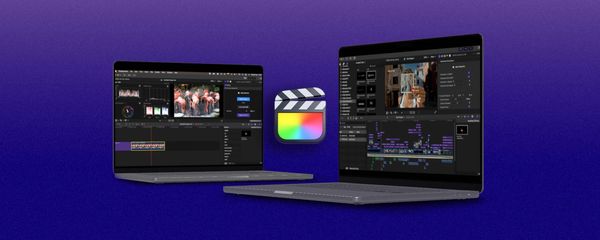How to use video editor templates
What are templates and why should you use them to make your edits shine?

Learning the lingo and becoming familiar with the terminology matters a lot in any domain of expertise you want to explore, and the world of video editing is no different. For instance, it can be quite difficult at first to grasp the difference between templates and plugins, especially if you’re not exactly a veteran of Final Cut Pro or video editing in general. Both are widely popular and described and advertised in a similar fashion, so you don’t need to be ashamed – better read our concise guide to templates and plugins instead!
What exactly are video editor templates?
First of all, templates can’t be used on their own – in order to benefit from them, you need video editing software, be it Final Cut Pro, Adobe Premiere, or any other. If you're still in the process of deciding which one will be best for you - check out our short guide to Best Video Editing Software of All Time! Once you decide that the built-in effects are not 100% what you need, or you simply want to save time, you can have a look at a variety of both paid and free templates to step up your editing game.
Templates are basically carefully designed, ready-made layout set-ups. Technically speaking, they are sets of pre-defined, often pre-animated and customizable motion designs, usually inspired by or meant for a certain theme. Editors use templates to save time and add consistency to their edits – and yes, if you’re up for it, you can create templates for others to use on your own!
It’s good to keep in mind that although these two functions are often confused (and overlap to a certain extent in terms of the required skill set and performed tasks), a video editor (whose job is to arrange footage and use graphics, music and effects to put together a story) is not the same as a motion designer (who focuses more on creating 3D motion graphics and animations that are subsequently used as elements in the editing process). Knowing that – apart from letting you show off some insider knowledge in editing-related contexts – will help you get your head around templates: you can see them as ready-made packages allowing you to touch up your edits with quality effects that would otherwise require the hand of a motion design artist.
Plugins vs. templates – what’s the difference?
Plugins are different from templates in more than just one aspect. For one thing, they work as software components, and their creation process is much more complex than in the case of templates, and typically requires some coding to be done. They also often come with an installer. Still, what matters most is the fact that plugins are meant as complete sets of various presets, such as titles, transitions, drop zones, lower thirds, backgrounds, pointers, add-ons and more. These elements are meant to provide you with new functionalities, which, depending on the plugin (and its publisher!), can range from pretty basic to Hollywood-style effects.
Technicalities aside, plugins offer more in terms of options and functionalities both vertically and horizontally – meaning that a plugin will present you with a much wider spectrum of features and allow you to customize them to suit your needs in a plethora of aspects, while templates – as the name suggests – are more ready-made packages of carefully crafted presets, with significantly fewer customization options.
Benefits of using video editor templates
Say, for instance, that you’d like to give your footage a bit of that powerfully suggestive, perturbing True Detective opening credits look. You know what double exposure is, and you have a general idea how to break down the way the intro was made into steps and substeps. Depending on your skill, time spent and effort made you can probably arrive at something digestible. Or… you could check out what you get when you get a ready-made, quality template – packed with customization options and tested by pros:
Need a more down-to-earth, practical example for your business-related activities?
Say you got commissioned by a paper-selling company and have to turn some corporate footage into something a little more than just watchable, and not want to end up with a world premiere of corporate crapfest? See how it’s done… with a template:
Got your attention? Keep reading to see how to start using templates!
How to use templates?
Getting started with plugins is quite simple: usually all it requires is unpacking the file that you downloaded and making sure that you copy it into the right folder on your machine (folder description is typically provided in the installation instructions). Depending on the source you get your template from, there may be a dedicated solution to ensure a more convenient, 100% smooth kick start of your template-assisted creative process. This is the case with MotionVFX: whether getting some of our free templates or buying from our store, you will be prompted to use mInstaller – a free app we developed for both MacOS and Windows to let you access all your templates and plugins collection with a few clicks.
How to use templates in Final Cut Pro?
If you’re using Final Cut Pro, you need to locate your template file and copy the entire folder it’s contained in into the correct location on your machine, so that the FCP software can find it. This usually means pasting it in:
{your user name}/Movies/Motion Templates/(either Titles or Generators folder)
The Titles/Generators choice can prove a little tricky, but since the options are limited to two, you should have your template up and running in no time!
Paid templates or free templates?
Let us say it loud and clear: we believe that your creativity and skill generally matter more than the size of your editing toolbox and its contents. Many editors will say that a lot can be done with templates that are available for free – you’ll probably hear it a lot when looking for info on using templates. What do you actually pay for when deciding to go for advanced, quality templates instead of relying on the ones that are available for free?
Well, templates are a great way to save time when editing your shots to perfection – and time is money! That, however, can be said about both free and paid templates. But if you use free templates, in most cases you will get only basic elements, often not conforming to current trends, or even a little outdated. No or very basic animation, very little or no customizability, few (and rather basic!) effects – these are the usual limitations you will run into when using free video editing templates.
What does it mean in practice? Your edits will be definitely less likely to stand out, as your choice of tools will be reflected in the final outcome of your trimming and cutting. And yes, the right template can make all the difference between an indifferent “meh” and an enthusiastic “wow!” – so you gotta ask yourself what you’re after, and how badly you want it!
While free templates can definitely be used to achieve very good results, it is also true that some levels can be reached only with the top tools available. If you can count, and value your time, it can often make more sense to pay for a template and utilize the saved time in any way you see fit. Considerations need to be made there!
Last but not least: let’s not forget we’re talking CREATING here, so it’s not all charts and numbers – the right template (or plugin!) can be that magic ingredient that will send you to another creative level. So, if you see something and just KNOW that you MUST HAVE it – we won’t blame you if you do! Been there so many times:)
Keep creating!




